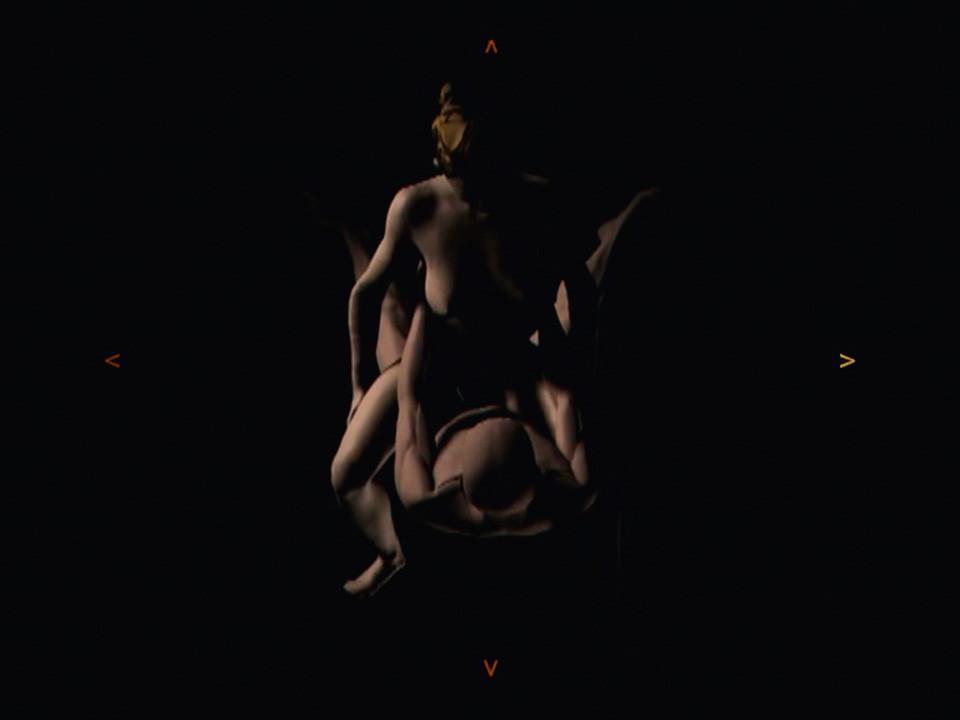Piotr Wyrzykowski
Cyborg’s Sex Manual 1.1.
Piotr Wyrzykowski
Cyborg’s Sex Manual 1.1., 1999, video-installation, 21 min 57 sec
Collection II of the Arsenal Gallery in Białystok. Work purchased by the Podlaskie Association for the Promotion of Fine Arts

Piotr Wyrzykowski’s Cyborg’s Sex Manual is an over 20-minute long, digitally generated recording of mechanical intercourse of male- and female-shaped cyborgs, and robots not clad in human bodies. The key to the reading of this work is the hypertext that is its integral part. Its interpretation comes from Wyrzykowski’s text The Developed Body of Technical Culture, developed (in the basic version) in 1995 and used in various actions. The set of hierarchically arranged statements is structurally close to Ludwig Wittgenstein’s Tractatus Logico-Philosophicus (Latin for “Logical-Philosophical Treatise”, published 1921). In fact, one of Wittgenstein’s most famous statements: “The borders of my language are the borders of my world” is the leitmotiv of Wyrzykowski’s lecture. Wyrzykowski’s reflection is founded on his own observation: the reinterpreted and gradually developed sentence “0.0.0. Language is a body”1. Wyrzykowski’s artistic search revolves around the issues of the body and identity, as well as the physical and identity-related integrity and/or fluidity.
References to the figure of a cyborg in Wyrzykowski’s works seem symptomatic to his understanding of the body. In the classic text A Cyborg Manifesto (1985) the American biologist and philosopher Donna Haraway wrote of cyborgs as sexless beings. The blurring of three borderlines constitutive to culture: that between man and animal (culture vs. nature), man and machine (the organic vs. the artificial) and physicality vs. non-physicality was, according to Haraway, the condition for a departure from the binary quality embedded in our cultural system. By the same token, let it be added here, the hybrid form and the disintegrated form began to function as new models of existence.
In Wyrzykowski’s works, cyborgness seems to be an inalienable quality of a human being. A cyborg, which is a figure of transgression, concurrently becomes a figure of man, whose identity is defined through the body2. Yet Wyrzykowski denies the body its closure within physicality designated by muscles and skin3. That body is transformed into information inscribed in the system of communication with another body, another organism (and another “I”)4. It can probably be perceived also as emotions attendant on various acts (including sexual acts) sent, received and registered outside of the continuum of the body. Wyrzykowski is convinced that soma is just one of the forms in which an organism may exist. He is searching for the body in isolation from its traditionally perceived boundaries. Hence he moves the body into virtual space, in which it may be subjected to a visual hybridization and multiplication, and it may be captured outside its physical contours that decide on its illusory integrity in the real world.
Izabela Kopania
translated from Polish by Klaudyna Michałowicz
- A similar phrase is found also in the video-installation discussed herein: “2.1 Language is your body”.
- 4.13 Your body is not a thing, but it is you yourself.
- 3.12 Your body passes from one body form to another.
- 1.3 Your body is information you identify with.

PLAN YOUR VISIT
Opening times:
Thuesday – Sunday
10:00-18:00
Last admission
to exhibition is at:
17.30